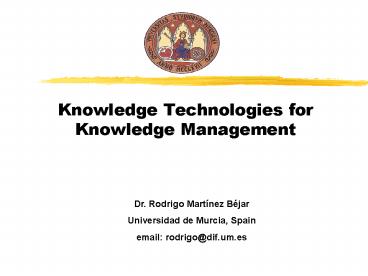Knowledge Technologies for Knowledge Management - PowerPoint PPT Presentation
1 / 32
Title:
Knowledge Technologies for Knowledge Management
Description:
Mereology. Taxonomy. Topology. Temporality. Influence. Axioms ... Mereology. Meaning: Science of theory of Parts. A part-of B -- A is a part of B. ... – PowerPoint PPT presentation
Number of Views:93
Avg rating:3.0/5.0
Title: Knowledge Technologies for Knowledge Management
1
- Knowledge Technologies for Knowledge Management
Dr. Rodrigo Martínez Béjar Universidad de Murcia,
Spain email rodrigo_at_dif.um.es
2
Contents of the presentation
- Ontological Engineering.
- Ontological Model.
- Knowledge Management.
- Applications of Ontological Engineering to
Knowledge Management. - Future Work.
3
What is an ontology?
- Meaning of existence
- In AI, if an entity can be represented then that
entity exists. - Explicit specification of a conceptualization.
- Conceptualization Structured interpretation of a
particular domain. - Set of concepts with relations between them.
4
Example
SCIENCES_FACULTY budget
PART-OF
PART-OF
PART-OF
PERSON age, income, role
BUILDING floors , height,
construction_date
KNOWLEDGE_AREA importance
IS-A
IS-A
STUDENT register_number, degree
STAFF dedication
IS-A
IS-A
PHD thesis_area
5
Concepts
- Ontological Knowledge Representation Basic Unit.
- All that can be represented.
- An ontology is comprised of a non-empty set of
concepts. - Attributes. Concept Properties. Specific Vs
inherited. Uniqueness. - Example
BUILDING
height,construction_date
6
Relationships
- They allow us to establish a conceptual hierarchy
in the ontology. - An ontology can be divided into subsystems
according to the existing relationships. - Examples of relationships.
- Mereology.
- Taxonomy.
- Topology.
- Temporality.
- Influence.
7
Axioms
- Rules for modelling conditions that must always
hold. - Types of axioms
- Structural. They derive from the existing
relations between concepts and the existence of
attributes. Example a IS-A b. - Non structural. Relations between attributes.
Example Fma.
8
Example
SCIENCES_FACULTY budget
PART-OF
PART-OF
PART-OF
PERSON age, income, role
BUILDING floors , height,
construction_date
KNOWLEDGE_AREA importance
IS-A
IS-A
STUDENT register_number, degree
STAFF dedication
IS-A
IS-A
PHD thesis_area
9
An Ontological model
- Elements.
- Concepts.
- Specific and Inherited Attributes.
- Relations.
- Taxonomic.
- Mereological.
- Temporal.
- Axioms.
- Structural.
10
Taxonomy
- Meaning Classification. A IS-A B --gt A is a
class of B. - Attribute inheritance. Taxonomic parents
Specific Attributes. - Properties Irreflexive, transitive and
asymmetric.
PERSON age, income, role
IS-A
STAFF dedication
11
Mereology
- Meaning Science of theory of Parts. A part-of B
--gt A is a part of B. - Properties Irreflexive, asymmetric and non
transitive.
SCIENCE_FACULTY budget
PART-OF
BUILDING height , construction_date
12
Types of mereologies
- Component/Object hand/arm.
- Member/Collection tree/forest.
- Portion/Mass piece of cake /cake.
- Characteristic/Activitypay/buy.
- Location/Area Murcia/Spain.
- Constituent/Object aluminium/plane.
- Phase/Process adolescence/development.
13
Temporality
- Meaning Temporal sequence of events or
processes. - Properties Irreflexive, transitive and
asymmetric.
BULB_FAILURE
AFTER
BULB_REPLACEMENT
14
Axioms
- Based on the internal structure Type Concept
has attribute. - Derived from the properties of the relations
between concepts. Type Concept A is not a class
of Concept A. - Temporal They establish temporal sequence
between concepts.
15
Further work
- Relations.
- Types of partonomies.
- Topology.
- Non-structural axioms.
- Structured Attributes.
16
Ontological Integration
- Process of unification of the knowledge collected
from a set of source ontologies. - Main Apportions.
- Co-operative work is promoted.
- Individual knowledge is enriched by including
others knowledge.
17
Knowledge Management (I)
- Control and Management of Organizational
Knowledge to achieve the organization goal(s). - Co-operative approach. Knowledge Sharing.
- High implication of the whole hierarchy of the
organization (staff and directives).
18
Knowledge Management (II)
19
Applications of Ontological Engineering to
Knowledge Management
- 1) Corporate environments.
- Goal Implementation of corporate memories by
using an Ontological Engineering based approach. - 2) Medical environments.
- Goal Intelligent Alarm Systems for ICU by using
an Ontological Engineering based approach.
20
Corporate Environments (I)
- Organization characteristics
- Strategy to achieve a goal.
- Resources .
- Intangible resources.
- Example Best practices.
- Inappropriate exploitation.
- Tangibles resources.
- Example Machinery.
21
Corporate Environments (II)
- The objective is to increase the performance of
the organization by making a better usage of the
available intangible resources. - Corporate Memory. Explicit, intangible, and
persistent organizational knowledge and
information representation
22
Towards our goal
- Managing a corporate memory implies
- Creation Each member gives his/her knowledge.
- Distribution All the members must be able to
access to the corporate memory. - Use The corporate memory must be used.
- Maintenance Verifying that the knowledge of the
corporate memory is valid, correct and
actualized.
23
Application of the Ontological Model
- The previous tasks can be made by our ontological
system - Creation Each user sends his/her ontologies.
Apportions Integration. - Distribution The system users can access the
global knowledge. - Use The knowledge can be visualized.
- Maintenance Checking for the consistence of the
memory and actualizing the ontologies.
24
(No Transcript)
25
Further work
- Adding new type of relationships
- Organizational environment.
- Higher realism.
- User facilities.
- Multimedia contents for facilitating knowledge
accessibility and understanding.
26
Medical environments
- ICU.
- Alarm systems.
- Associated problems.
- Low specificity.
- Superfluous alarms.
- Objective Intelligent Alarm System.
- Superfluous alarms detection.
- Precise information about the event.
27
OBIAC
28
ICU Ontological Model
29
Application of the Ontological Model
Applied to
- Diagnosis Hypotheses formulation.
- Patients evolution.
- Checking diagnoses.
- Superfluous alarms detection.
- Selection of possible diagnoses.
30
Checking diagnoses
evolution
hypothesis
31
Superfluous alarms detection
hypothesis
evolution
32
Further work
- Interconnecting several ICUs.
- Multiple diseases management.
- Reuse of hypotheses.































